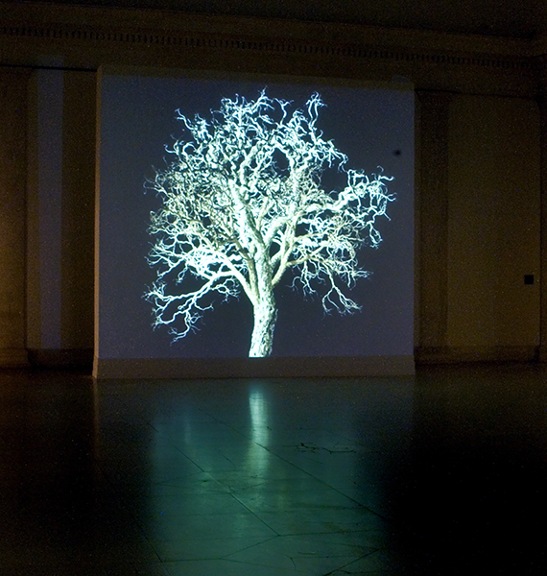A Winter Tree: Jennifer Steinkamp
I’m fairly certain that many of us have experienced the sight of snow-laden trees in January. That is my favorite part of winter. What better image to conjure up the sensation of a cold winter day than an artist’s impression of a beautiful tree? Video artist Jennifer Steinkamp has captured just that in her astounding work, Dervish I. If this image of the winter tree from the installation does not summon such sensations, then nothing will!
 |
| Jennifer Steinkamp (born 1958, U.S.), Dervish I, video installation, 2004. Digital projection. Collection of Buffalo AKG Art Museum, Buffalo, NY. © 2024 Jennifer Steinkamp. (AK-3697) |
The tree in Dervish I is based on a photograph of a maple tree that Steinkamp animated to move and reflect different seasons. Four trees are projected in the installation, each displaying foliage (or lack thereof) in spring, summer, autumn, or winter. Shown slowly rotating from side to side in each season, the trees symbolize the transience of life. The work references members of the Mevlevi Order, known as dervishes, who whirl in a practice of meditative prayer during the Sufi sema ceremony. A video of the installation is available on Vimeo.
Light in or as a work of art has been explored since the early 1900s. Initially, devices were programmed to produce shifting patterns of colored light. These originated with the motion and light experiments of László Moholy-Nagy (1895–1946) of the Bauhaus and the color organ (Clavilux), invented by Thomas Wilfred (1889–1968).
The combination of film and works of art came about in a big way in the late 1950s and early 1960s with the advent of Happenings. The only documentation of these temporary art performances was photography or film. By the late 1960s, the impact of TV as a major cultural phenomenon spawned the use of TV imagery in works of art, both still and projected.
By the mid-1970s, video was becoming a new art medium. Video artworks evolved through the 1980s into the 1990s, when it was universally accepted as a fine art form. In the 21st century, sophisticated video art, augmented by digital or manual manipulation, has elevated the art form to become part of both gallery and museum collections. Video work can form part of an art installation, create immersive installations, and be projected in monumental proportions in or on architecture.
Originally from Denver, Colorado, Steinkamp earned a BFA in 1989 and MFA in 1991 from the ArtCenter College of Design in Pasadena, California. Steinkamp also studied experimental animation at CalArts in the 1980s. She now lives and works in Los Angeles. The new media artist often projects onto buildings, making them come alive with 3D digital animation. The movement of natural and humanmade forms alter spaces in these site-specific installations in ways that are both enticing and unsettling. Time is a recurring theme of Steinkamp’s work, particularly seasons and life cycles.
Correlations to Davis Programs: Explorations in Art 2E Grade 2: 1.1; Explorations in Art 2E Grade 4: 1.8, 6.6; Explorations in Art 2E Grade 6: 5.2; The Visual Experience 4E: 9.3, 9.4, 11.5


Comments